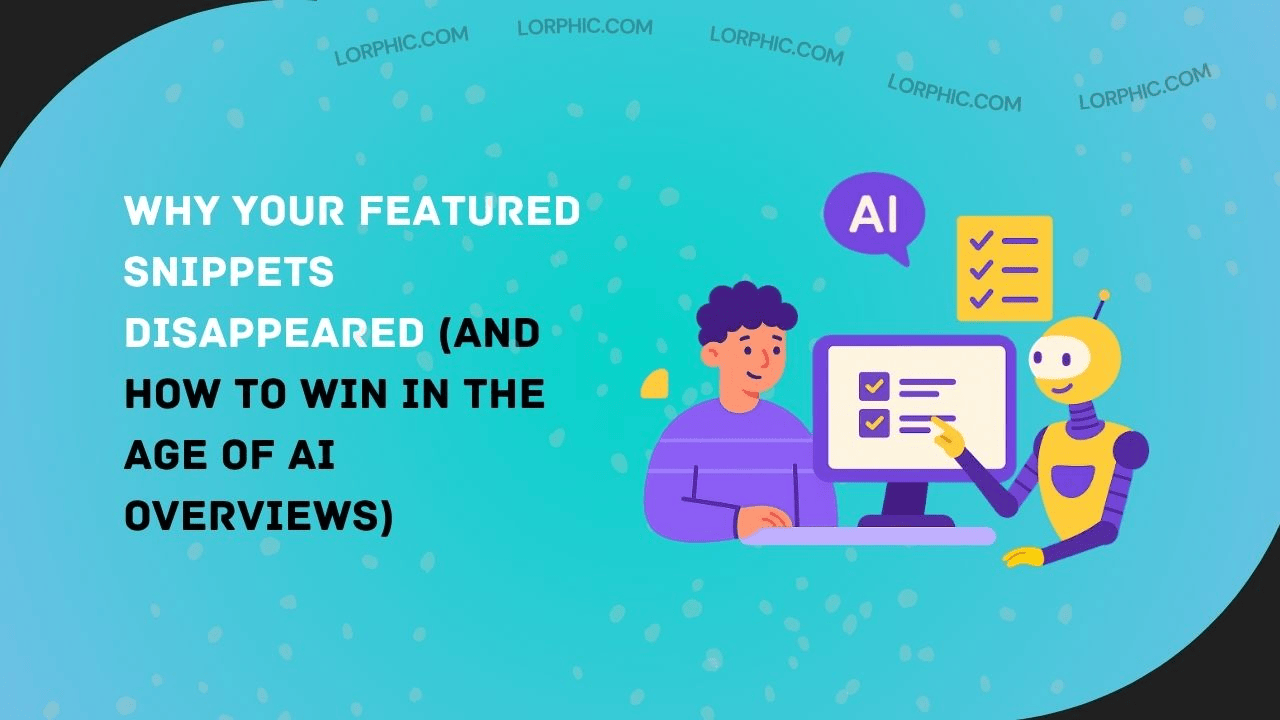Ugh. You know the feeling. It’s that heart-sinking lurch you get when you check your rankings.
One day, you’re the undisputed king of the castle. Your website is sitting pretty in that glorious, border-rimmed Featured Snippets box at the very top of the Google SERPs. It’s more than just a ranking; it’s a coronation. Your search visibility is a supernova, the organic clicks are pouring in, and you’re strutting around the office (or your living room) feeling like an SEO demigod. You didn’t just win the game; you are the game.
The next day? Poof. Gone. Vanished into the digital ether.
And in its place is… well, something else entirely. Maybe a competitor you’ve been battling for months finally snatched your crown. Or maybe, and this is the new reality for us in late 2025, there’s a big, polished, AI-generated block of text where your hard-won snippet used to be.
You’re staring at your screen, your coffee forgotten, muttering the universal, soul-crushing question: “Why in the world did my Featured Snippets disappear?!”
If this is you, take a deep breath. You’re not alone, and you’re not going crazy. The ground is shifting beneath our feet, my friend. The game has fundamentally changed. So let’s pour a fresh cup, get comfortable, and talk about what’s really going on and how to fight back.

The Culprits: The Usual Suspects & The New Player Changing Everything
Think of your snippet spot as the most desirable storefront on Main Street. There are a few classic reasons you might get evicted, but there’s also a brand-new, mega-mall being built right on top of your property, and you need to understand the blueprints.
The Elephant in the Room: AI Overviews Are Taking Over
Let’s tackle this head-on, because it’s the biggest, most disruptive reason snippets are vanishing today. Google is all-in on AI Overviews. These are the detailed, AI-generated summaries that now dominate the top of many search results, especially for informational queries.
In the “old days” (like, 2023), Google acted like a librarian. You’d ask a question, and it would point you to the best single book (your webpage) that had the answer, displaying a neat little excerpt.
Now, Google is acting like a super-intelligent research assistant. It reads the top five or ten books, synthesizes the key information from all of them, and presents you with a custom-written summary, complete with citations.
So, in many cases, your Featured snippets didn’t just disappear; it was likely absorbed, cannibalized, and replaced by an AI Overview.
- Example: Let’s say your snippet was for the query “how to propagate a snake plant.” Your beautiful, bulleted list of steps was featured. Today, a user searching for that might see an AI Overview that starts with, “Propagating a snake plant is easy and can be done in a few ways…” followed by a synthesized summary of methods pulled from your site, a gardening blog, and maybe even a YouTube video transcript.
The goalpost has moved. The new goal isn’t just to be the answer box; it’s to be a primary, can’t-be-ignored source for the AI that builds the answer box. This is the heart of modern Answer Engine Optimization (AEO).
The Competition Got Better (And Ruthlessly Smarter)
While AI is the big story, never discount the classics. Your competitors want your spot, and they are working just as hard as you are. They might have dethroned you because they:
- Created a More Comprehensive Guide: Your post explained how to propagate a snake plant. Theirs explained how, listed common mistakes, recommended the best soil types, and included a gallery of successful propagations. They didn’t just answer the question; they answered the next three questions the user would have had.
- Used Better Structuring and Schema: Perhaps they implemented “How-To” schema markup on their page. This is like handing Google a perfectly formatted instruction manual for their content, making it incredibly easy for algorithms (and AI) to understand the steps.
- Offered a Better User Experience: Maybe their page loads half a second faster, has a step-by-step video embedded at the top, and doesn’t have an annoying pop-up ad. In a tie, Google will always favor the page that provides a smoother user experience.
Think of it like a bake-off. Your chocolate cake was delicious and won last year. This year, someone else showed up with a three-tiered red velvet cake with cream cheese frosting and a detailed recipe card. It’s just a better offering.
You Changed Your Content (The “Oops, I Broke It” Factor)
Oh, this one stings because it’s usually self-inflicted. You go into your CMS with the best intentions. “This post is two years old,” you think, “I’ll just refresh it!” But in the process, you might have accidentally performed digital surgery with a sledgehammer.
- The Well-Meaning Rewrite: A copywriter might “improve” a clunky but effective sentence like, “The best temperature for growing basil is 70°F,” changing it to the more poetic, “Basil plants truly thrive when they are kept in a consistently warm environment, reminiscent of their native Mediterranean climate.” The second sentence is lovely, but the first is a perfect, snippet-able fact. You “fixed” the prose but broke the snippet.
- The Design Tweak: A developer might change your page template, altering the heading structure. The key paragraph that was under a clear
<h2>tag asking “How Do You Propagate a Snake Plant?” is now under a generic<h3>for stylistic reasons. That semantic clue that Google was relying on is now gone.
This is why tracking changes on your most important pages is critical. A small, seemingly harmless update can undo months of hard work.
User Behavior is the Ultimate, Silent Judge
Google is the ultimate people-pleaser. Its entire business model rests on providing users with satisfying results, fast. They measure this satisfaction through user behavior.
If users click your snippet, land on your page, and then immediately hit the “back” button (this is called “pogo-sticking”), it sends a massive, blaring red flag to Google. It’s the digital equivalent of a user shouting, “Nope, this wasn’t it!” It tells Google that your title and snippet were promising, but your actual page failed to deliver.
What causes this?
- Slow Page Load: If your page takes more than 3 seconds to load, users are gone.
- Aggressive Ads or Pop-ups: Nothing makes people flee faster than a giant pop-up covering the content they came for.
- A “Wall of Text”: If your content isn’t broken up with headings, short paragraphs, and images, it’s intimidating and exhausting to read.
- Bait-and-Switch: Your snippet promises a quick answer, but the answer is buried 1,000 words down the page beneath a long, rambling intro.
Your job isn’t just to get the click; it’s to earn the click by satisfying the user so completely that they have no reason to go back to the search results.
How to Fight Back: Your New Goal is to Be in the AI Overview
Alright, enough with the diagnosis. Let’s talk about the cure. Losing your spot is a signal to adapt. Here’s your new battle plan for the AI-driven SERP.
1. Audit Your Content for the AI Era
Go back to that page and look at it with fresh, critical eyes. It’s time for a “Snippet Gap Analysis.”
- Analyze the New Winner: Look at who is featured in the AI Overview. What phrases are they using? How is their content structured? What questions are they answering that you aren’t? You need to deconstruct their success.
- Implement Question-First Formatting: Structure your key sections like a Q&A. Use a heading that is the literal question (e.g.,
<h2>What is the Best Soil for a Snake Plant?</h2>). Then, in the very first paragraph right below it, provide a direct, concise answer. Elaborate after you’ve given the core answer. This makes your content incredibly easy for AI to parse and cite. - Refresh and Strengthen: Add new information, update statistics, embed a new video, or include a helpful FAQ section at the end. Answering related questions in one place makes your content a one-stop-shop, which Google loves. When you’re done, republish it with the current date to signal its freshness.
2. Become an Unmistakable Authority (E-A-T on Steroids)
In an internet flooded with AI-generated fluff, proving you’re a real, trustworthy expert is your superpower. This is what Google calls E-A-T (Expertise, Authoritativeness, Trustworthiness).
- Expertise (Show, Don’t Tell): Don’t just say you’re an expert. Prove it. Have detailed author bios with credentials and links to their social profiles. Show original research, data, or case studies. If you’re writing about plants, show pictures of your actual plants.
- Authoritativeness (Get the Right Signals): This is about your reputation. Earn backlinks and mentions from other well-respected sites in your industry. If other experts are citing you as a source, Google’s AI will notice.
- Trustworthiness (Be a Real Business): Make it easy for users to trust you. Have a clear “About Us” page, easy-to-find contact information, a privacy policy, and a secure (HTTPS) site. Customer reviews and testimonials are pure gold here. For the ultimate guide on this, read Google’s own Search Quality Rater Guidelines. It’s dense, but it’s the playbook.
3. Double Down on User Engagement to Keep Them Hooked
Remember, your goal is to stop the “pogo-sticking.” You need to create content that draws people in and keeps them there.
- Go Beyond Text: Can you add an interactive element? A mortgage calculator on a finance page, a printable checklist on a DIY guide, or a quick quiz on an educational post can dramatically increase the time users spend on your page.
- Create Content Hubs: Don’t just write one article. Build a “topic cluster.” If you have a pillar post on “Snake Plant Care,” link out from it to more specific articles on “Propagating,” “Common Diseases,” and “Best Potting Mixes.” This positions you as an authority and keeps users clicking through your site.
- Optimize “Above the Fold”: What users see in the first few seconds without scrolling is critical. Make sure your opening paragraph immediately confirms they’re in the right place and gives them a reason to keep reading.
4. Stay Obsessively Updated on Google’s Moves
You can’t win the game if you don’t know the rules. The search landscape is evolving monthly. Follow trusted sources to stay ahead of the curve. The Google Search Central Blog is essential, but also follow industry leaders like Search Engine Land, Moz, and key SEO experts on social media who analyze these changes in real-time.
Don’t Mourn the Featured Snippets, Master the SERP
Losing a Featured Snippet feels like a demotion, but I want you to reframe it. It’s an invitation to level up your entire content strategy. The Google SERPs are no longer a simple list of links; they are a dynamic, AI-powered answer engine.
Your job has evolved. It’s no longer about tricking an algorithm into giving you a special box. It’s about creating content so good, so clear, so authoritative, and so genuinely helpful that Google’s AI has to use you as a foundational source for its own answers.
This is the future of SEO. This is Answer Engine Optimization. So, dust yourself off, get back in there, and reclaim your influence not just in one little box, but as an indispensable part of the answer itself. You got this.
Curated by Lorphic
Digital intelligence. Clarity. Truth.




